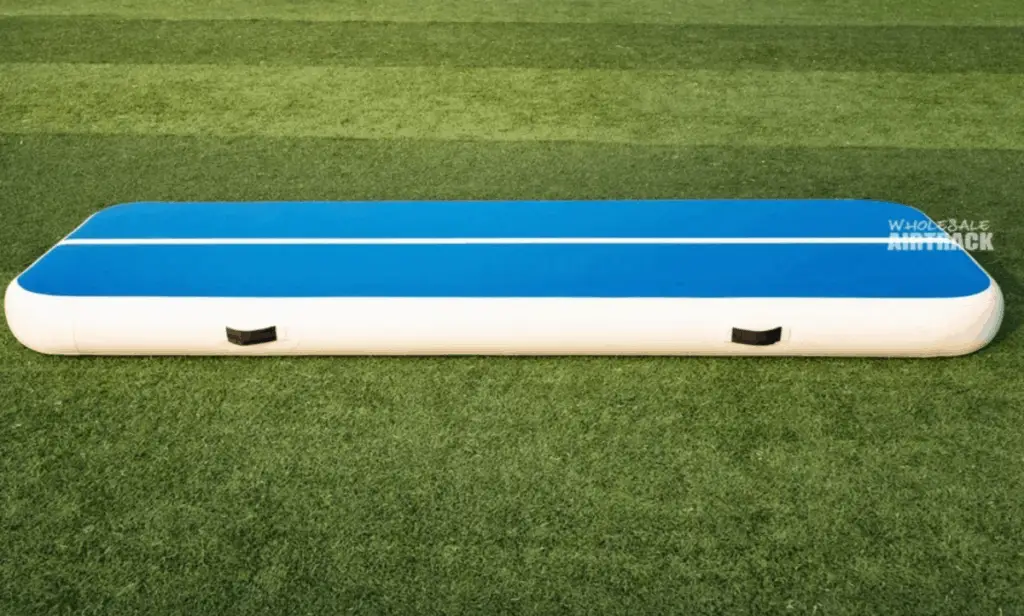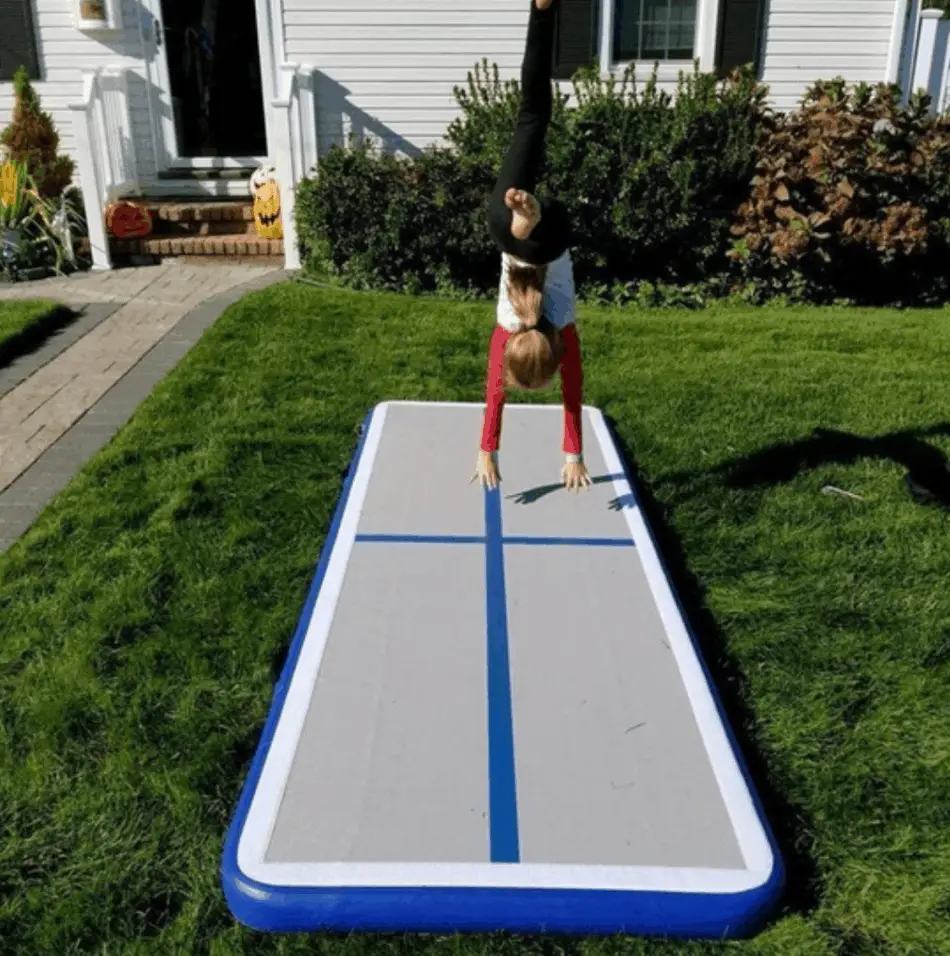Gymnastics air tracks are a vital piece of gymnastics equipment when it comes to staying safe when you practice your gymnastics skills. However, simply having a gymnastics air track and practicing on it does not necessarily mean that you will avoid injury.
Surprisingly, it is entirely possible to use an air track incorrectly. This can make your training just as dangerous, potentially even more so than training without an air track at all. So, you need to know how to be safe on your gymnastics air track.
To be safe on your gymnastics air track be sure to:
- Check On The Air Pressure of the Air Track Regularly
- Make Sure The Area Is Safe
- Perform Movements Within Your Abilities
Benefits Of Using A Gymnastics Air Track
Gymnastics air tracks can be a great asset to work on your tumbling skills and your flips. Your combination skills, in particular, can benefit from you working on an air track. The lines on most air tracks are there to help your orientation when you are flipping and turning so that you can move in a straight line.

Because an air track reduces the amount of impact that your body feels, you can train for longer without feeling as sore from it. This lets you train the amount of time you need to in order to nail down the skills you are working towards mastering.
When an air track has the right amount of air pressure, it is slightly bouncy. This has, in a small way, an effect like a trampoline and gives you more height. When you are first learning your flips and how to do roundoffs, this extra height may mean the difference between landing solidly on your feet or not quite making it.
And these are just a few benefits of using an air track. There are many more air track benefits that I could list. However, to get the most out of these air track benefits, you have to stay safe on your air track. After all, you can’t train on your air track if you get yourself hurt.
Check On You Air Track Regularly
One of the first ways to be safe on your gymnastics air track is to check your air track for possible problems on a fairly regular basis. First, your air track should be properly aired up, without having too much or too little air.
Too much air pressure will make your air track too stiff. If you land on it hard or fall on a too hard air track, you risk bursting any weak seams. Too little air pressure in your air track will not cushion you and will through you off by causing you to sink into it.

If your air track is kept outdoors, checking the air pressure in it is even more important. Heat affects the air pressure in your track, making your air track stiffer with a greater amount of pressure. Cold air, conversely, decreases the air pressure in your air track.
However, leaks can also cause a decrease in your air track’s air pressure, so you should check for these on a regular basis. Go over your whole air track on occasion and look for any signs of wear and make sure that there are no threads or seams that are getting thin.
Thin seams can be thickened before any damage is done to your air track, so it is best to catch these as early on as possible. In addition, any direct heat can melt the air track slightly, creating what appears to be a bubble in a spot on your air track.
A bubble in the fabric does not mean that your air track is unusable. However, it should be repaired if at all possible since the bubble is a weak point and could burst if you land on your air track too hard.
Make Sure The Area Is Safe
Common sense when practicing gymnastics skills should tell you that something as obvious as a glass table right next to the gymnastics air track you are training on is a recipe for disaster. As obvious as that example is, there are many things less drastic that can still be dangerous.
There should be no furniture or anything hard on any side of a gymnastics air track. Any nearby concrete should be padded with a mat or something. There should also be no cords, wires, or anything of that nature near your gymnastics air track.
If these obstructions have to be there, they should at least be covered with a tarp or something. You do not want to fall off your air track and get yourself tangled up. Covering the whole area around your gymnastics air track with mats is something that you should strongly consider doing if at all possible.
One of the areas around your air track that you should take particular care to clear are the beginning and the ends of the air track. For practicing your tumbling passes, you will need to have a clear area before the air track starts to get a running start.
If you misjudge the length you need for your pass, you can easily end up going off of the end of your gymnastics air track. Most gymnastics gyms have a foam pit or something else at the end of their air tracks for this reason.
While having a foam pit is not exactly practical if you are training at home, you should still make sure that whatever is off the end of your air track will give you a soft landing. Just use a bit of common sense and make sure nothing is near your air track.
Other Safety Tips For Your Air Track
When practicing your gymnastics skills, you should always wear clothing that won’t get in the way. Clothing is even more important when you are training on a gymnastics air track or on other gymnastics equipment.
For training on your air track, it is best to wear your gymnastics leotard. If you do not like to wear a leotard, you must wear something that fits your form well without restricting your movements in the slightest.
Socks can slip on some air tracks. So, you should avoid wearing socks on an air track or wear socks that are specifically non-slip. Meanwhile, your hair should also be pulled back and out of your way so that it does not get in your eyes.
Other than wearing clothing that is appropriate for training, you should also avoid getting ahead of yourself. It can feel very tempting to go ahead of where your coach has you and to try to work on a new skill on your own.
However, your coach knows much better than you if you are ready for a new skill. The first few times you try a new skill is when you are most likely to make the serious errors that could lead to you getting hurt.
Having your gymnastics coach present to supervise the first few times you try a new skill, therefore, gives you someone right there to help. It also provides you with feedback from someone who can tell you what you are doing wrong.
Final Thoughts
While fooling around on your gymnastics air track can be a lot of fun, this often leads to injuries of some kind. There is no doubt that air tracks can be fun, but they are still a piece of equipment that is made for serious training.
Before you start using an air track at all, you should know the basics of how to fall safely. Falling is one of the first things that most gymnasts learn how to do. This skill is one that is useful even on gymnastics air tracks.
Sometimes, despite your efforts, you can end up off of the side of your air track. Therefore, knowing how to fall without getting hurt is vital no matter what you are training on. Gymnastics air tracks do an excellent job of helping you to avoid injuries.
However, when training on an air track, you should always use our common sense. Just because air tracks are useful for helping you avoid getting hurt, this does not always prevent you from getting hurt if you are not careful.

